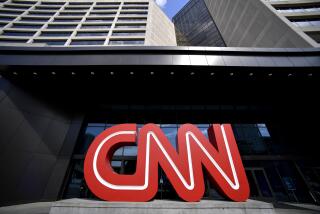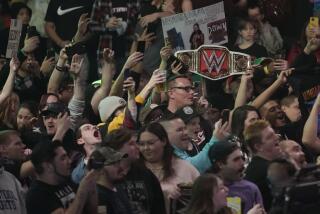CW Network Faces Struggle to Find a Winning Strategy
- Share via
CBS Corp. and Warner Bros. launch their new television network tonight with the latest installment of the Tyra Banks’ contest, “America’s Next Top Model.” But in the coming months, the CW must do something trickier than strut down a runway in 4-inch stilettos: It must make money.
That mandate was set this year by CBS Chief Executive Leslie Moonves. It’s a feat that the network’s two predecessors -- the defunct WB and UPN -- were never able to consistently achieve. Throughout their 11-year histories, the rival operations together lost nearly $2 billion in their struggles to find a winning strategy. In January, the companies decided to cut their losses and agreed to form a new network with their most popular shows.
Although CBS and Warner Bros. no longer will have to scratch and claw for the same audience of teenagers and young adults, viewers these days still are not an easy catch. Internet sites such as YouTube and MySpace have become the coolest destinations around.
The CW has “got to build an identity and a sense of community,” said Shari Anne Brill, programming director for ad firm Carat.
That could be difficult given the confusion generated by the consolidation. “We have a big challenge ahead of us,” said Dawn Ostroff, the former head of UPN who is the CW’s entertainment president. “Our first goal is to bring the viewers into the CW tent -- bring in the audience that has always been there.”
Although many of the CW programs already have a following, many viewers probably won’t know where to find them. That’s because the merger triggered a domino effect across the country as dozens of stations orphaned by the shutdown of UPN and WB scrambled to fall into line behind either the CW or an alternative prime-time telenovela network put together by News Corp. The CW will be available in 93% of the country.
The spine of the CW will be made up of TV stations owned by CBS and Tribune Co. Chicago-based Tribune, which publishes the Los Angeles Times, owned a minority interest in the WB network but won’t have a stake in the CW. CBS owned UPN.
The station shuffle could frustrate some viewers with well-worn habits. For example, instead of flipping to UPN for “Top Model” or World Wrestling Entertainment’s “Smackdown,” fans of those shows might have to channel surf. In more than half of the country, former UPN viewers will have to switch to a channel previously occupied by the WB for their shows. This is the case in Los Angeles, where the CW will air on Tribune’s KTLA-TV Channel 5. In a quarter of the country, viewers looking for such WB stalwarts as “7th Heaven,” “Smallville” and “Gilmore Girls” will have to turn to the old UPN channel. Some viewers will find the CW on a channel that was neither a UPN nor a WB affiliate.
“It’s going to take a little time for the dust to settle,” Ostroff said.
For that reason, the CW will launch with 11 veteran shows and only two new ones. Network executives wanted to keep the schedule stable so that they could spend their marketing dollars promoting the network, not individual shows.
That saved tens of millions of dollars. The CW’s programming budget is slightly less than the more than $500 million a year the WB spent on programming. Executives declined to provide financial details.
The CW’s lineup includes the long-running WB family drama, “7th Heaven,” which was scheduled to be sent packing in May because it lost $16 million a year for the WB. The CW was able to keep the drama alive because one of its parents, CBS, produces it. The studio reduced the cost by shrinking the size of the cast and slashing salaries of the actors.
Although Moonves vowed in January that the new venture would be profitable, the two executives charged with the day-to-day operations of the CW stopped short this month of saying it would be in the black.
“We are poised for much greater success than either the WB or the UPN,” said John Maatta, the CW’s chief operating officer and a former WB executive. “I expect lift.”
To get aloft, the CW has hired about 250 people -- about 50 fewer than the WB had but about 50 more than UPN. That means the merger resulted in the loss of about 250 jobs.
Winnowing the workforce “was the hardest part of the whole endeavor,” Maatta said, adding that the new network had about an even mix of employees from the WB and UPN. Employees of the CW will move into its new Burbank office next week.
The network was encouraged by its commercial sales during the so-called upfront market. The CW’s sales force pulled in more than $640 million in commitments for 85% of its prime-time advertising inventory this season. The network also initiated “Content Wraps,” two-minute segments that blend entertainment and advertising and are woven throughout a night of programming. Up tonight during “Top Model” will be hair tips sponsored by Clairol Herbal Essence.
Bill Morningstar, the CW’s sales chief, said a big challenge was to get advertisers to pay comparable rates for African American comedies airing Sunday nights, including Chris Rock’s “Everybody Hates Chris.”
“It took a lot of work, but we were able to get Sunday night priced at the same value as the rest of the network,” he said.
Advertisers expect the CW’s ratings to eclipse those of its predecessors. The WB and UPN each averaged about 3 million viewers a week. CW executives declined to divulge their goals, saying only they hope to surpass the ratings by the end of the season. The network is targeting young adults aged 18 to 34.
Said Brad Adgate of Horizon Media: “I don’t expect them to double the ratings of the WB, but there should be some moderate increases.”
Another challenge for the CW is to develop a niche for a generation weaned on unscripted shows and the Internet. Even more than the big broadcast networks, advertisers said, the CW must be nimble to embrace changes in consumers’ tastes.
Taking a page out of MySpace’s playbook, the CW has created its own networking hangout on its website called “CW lounge.” Viewers can chat about their favorite show and submit their own videos. Ostroff said some would be selected for use as on-air promotional spots.
“You can’t force a social network,” said Laura Caraccioli-Davis of ad buyer Starcom USA. “That just happens. It’s hard to say whether they will be successful. In some ways, it seems like they built the network for today, but I wonder whether it’s the right model for tomorrow.”
Ostroff doesn’t share those doubts. “We’re developing a lot of things in a traditional way and a nontraditional way,” she said. “The Internet presents challenges, but people like stories. And there is nothing like television that can give that to them.”
*
More to Read
The biggest entertainment stories
Get our big stories about Hollywood, film, television, music, arts, culture and more right in your inbox as soon as they publish.
You may occasionally receive promotional content from the Los Angeles Times.











